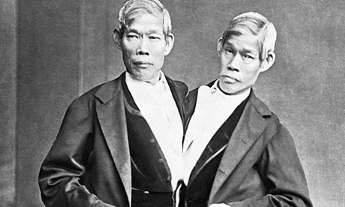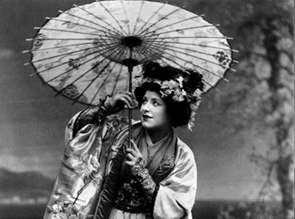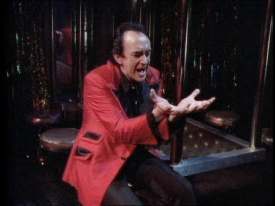Yellowface!
Yellowface on Stage
"Yellowface" portrayals date to at least 1767 in the United
States, when Arthur Murphy's theatrical work The Orphan of China was presented in Philadelphia. In these early productions, both the actors and the audiences had never seen a real, live Asian.
Museums and circus performances featured the "oriental" as well as other
exotic racial groups for both education and entertainment. In 1834, a "Chinese Lady" named Afong Moy was put on display for public viewing at the American Museum in New York City. Other exotic displays from Asia followed throughout the nineteenth century, including the most famous, the "Siamese Twins" Chang and Eng.

Chang and Eng -- The Original Siamese Twins
On October 18, 1852, the first real Chinese theatrical performance was presented on stage at the American Theater on Sansome Street in San Francisco by the Tong Hook Tong Dramatic Company, a
forty-two member Cantonese opera troupe from Guangdong Province.
By the 1870s, popular representations of Asians in mainstream theatre began to reflect the anti-Asian sentiments. Stereotypical characters, both male and female, repeatedly appeared on American stages and made a lasting impression on the public
imagination. In Henry Grimm's play, The Chinese Must Go (1879),
two diametrically opposite Asian male stereotypes: the childish Chinaman speaking pidgin English (and who is often drunk, high on opium, and chases white women), and the "evil genius" Chinaman who speaks perfect English and has the ability to negotiate with white Americans. The latter threatens to take over California and plots to ruin the lives of white American while the former corrupts innocent white children and women with his immoral and ignorant acts. Variation of these
stereotypes appeared in other mainstream theatre shows, such as Ah Sin!
by Mark Twain and Bret Harte.
Female stereotypes were not any better: the images were either the innocent self-sacrificing lotus blossom or the much feared dragon lady. These images began to receive increasing visibility and popularity with the emergence of
"orientalist" romantic melodramas at the turn of the 20th Century.
The opera Madame Butterfly is the story of a Japanese maiden named Cio-Cio
San, who falls in love with a white American navy lieutenant. The Japanese girl and the officer have a child. The American
sailor leaves while Cio-Cio San blissfully awaits his return, but he later
returns to Japan with his American wife. The heartbroken Japanese girl bids farewell to her callous lover, then kills herself.

Geraldine Farrar, who played the role of
Cio-Cio-San (1907-1927) at the
Metropolitan Opera.
There has been much controversy about the opera, especially its sexist and racist
themes. The fact that it is the most-performed opera in the United States, where it ranks as Number 1 in Opera America's list of the 20 most-performed operas in North
America, only helps to perpetuate the notion of the dominant white male over the subdued Asian female who can be cast
aside as described by Sheridan Prasso in her book, The Asian Mystique: dragon ladies, geisha girls, & our fantasies of the exotic orient published in 2005.
Miss Saigon (1989 - 1999) a London's West End musical, is loosely based on Madame
Butterfly. The setting of the plot is relocated to the 1970s Saigon during the Vietnam War, and Madame Butterfly's American Lieutenant and Japanese geisha coupling is replaced by a romance between an American GI and a Vietnamese bar girl. This musical has received criticism for what some have perceived as a racist or sexist overtone, including protests regarding its portrayal of Asian men, Asian women, or women in
general.
Originally, Jonathan Pryce and Keith Burns, white actors playing Eurasian/Asian characters, wore eye prostheses and bronzing cream to make themselves look more
Asian, which outraged some who drew comparisons to a "minstrel show". From April 1989 to May 1990, nearly 100 shows were produced under the agreement between Equity and the League of American Theatres and Producers, 33 of the shows, with 504 roles, had no ethnic minority actors and 12 other productions had only one or two ethnic
actors.
 Jonathan
Pryce plays the Eurasian brothel owner in Miss Siagon
In the London production of Miss Saigon, Lea Salonga originally starred as Kim, with Jonathan Pryce as the Engineer. When the production transferred from London to New York City, the Actors' Equity Association
(AEA) refused to allow Pryce, a white actor, to recreate the role of the Eurasian pimp in America.
As Alan Eisenberg, executive secretary of Actors' Equity explained, "The casting of a Caucasian actor made up to appear Asian is an affront to the Asian community. The casting choice is especially disturbing when the casting of an Asian actor, in the role, would be an important and significant opportunity to break the usual pattern of casting Asians in minor
roles."
|

